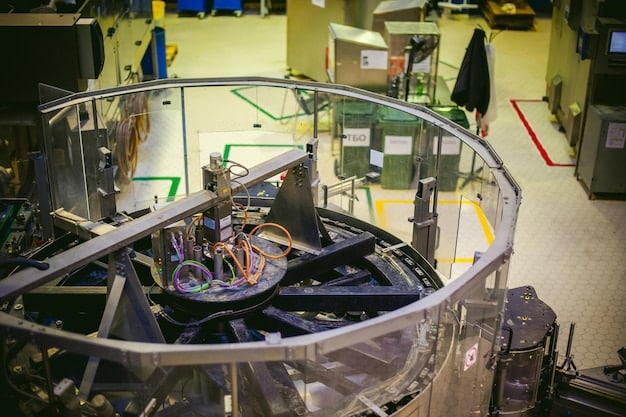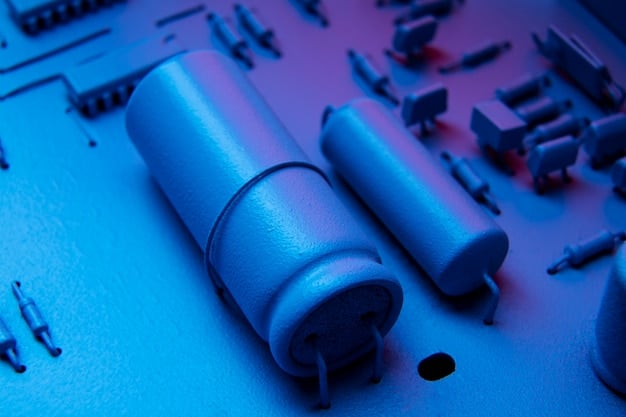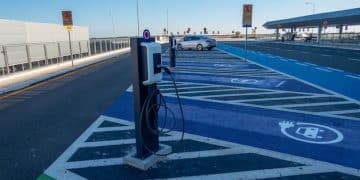Electric Vehicle Battery Production: US Gigafactory Impact by 2027

Electric vehicle battery production in the US is poised for significant growth by 2027, driven by new gigafactories that will reshape supply chains, reduce reliance on foreign sources, and potentially lower EV costs for consumers.
The landscape of electric vehicle (EV) battery production is rapidly evolving in the United States. New gigafactories are emerging across the country, promising to reshape supply chains and significantly impact the availability and affordability of EVs by 2027. Understanding the scope and implications of this growth is crucial for anyone interested in the future of transportation and the automotive industry. This article explores the transformative potential of domestic electric vehicle battery production: How New US Gigafactories Will Impact Supply Chains by 2027.
The Rise of US Gigafactories: A New Era for EV Batteries
The United States is witnessing a surge in the construction of gigafactories dedicated to producing EV batteries. This expansion is driven by increasing demand for electric vehicles, government incentives aimed at boosting domestic manufacturing, and the strategic goal of securing a reliable supply chain for this critical component.
Key Players Investing in US Gigafactories
Several major players are involved in establishing gigafactories across the US. These include established automakers, battery manufacturers, and joint ventures focused on battery production.
- Tesla: A pioneer in electric vehicles, Tesla continues to expand its battery production capacity through its Gigafactory network.
- General Motors (GM): GM is investing heavily in battery production through its Ultium Cells joint venture with LG Energy Solution.
- Ford: Ford is partnering with SK Innovation to build battery plants under the BlueOval SK banner.
- LG Energy Solution: As a leading global battery manufacturer, LG Energy Solution is expanding its presence in the US through joint ventures and standalone facilities.
These investments reflect a commitment to securing a domestic supply of EV batteries, reducing reliance on foreign sources, and fostering innovation in battery technology.

The emergence of US gigafactories marks a significant shift towards greater self-sufficiency in the EV battery supply chain. This trend is expected to continue as demand for electric vehicles continues to rise.
Impact on the Electric Vehicle Supply Chain
The localization of EV battery production within the United States is set to have a profound impact on the overall supply chain. By establishing domestic sources for batteries, automakers can mitigate risks associated with international trade, transportation costs, and geopolitical instability.
Reduced Reliance on Foreign Suppliers
Currently, a significant portion of EV batteries and their components are imported from overseas. The establishment of US gigafactories will reduce this dependence, strengthening the domestic EV industry and making it more resilient to external disruptions.
Gigafactories bring several benefits to the supply chain:
- Shorter Lead Times: Domestic production reduces the time required to procure batteries, allowing automakers to respond more quickly to market demands.
- Lower Transportation Costs: Reduced reliance on international shipping translates to lower transportation costs, making EVs more affordable.
- Greater Supply Chain Control: Domestic production provides automakers with greater control over the quality and availability of batteries.
The strategic importance of a secure and reliable EV battery supply chain cannot be overstated. As the automotive industry transitions to electric vehicles, having domestic sources for batteries will be essential for maintaining competitiveness and ensuring a stable supply of vehicles.
Ultimately, the impact of US gigafactories on the EV supply chain is expected to be transformative. By reducing reliance on foreign suppliers and fostering a more localized ecosystem, these facilities will play a critical role in accelerating the adoption of electric vehicles in the United States.
Technological Advancements in Battery Production
The new wave of US gigafactories is not just about increasing production capacity; it’s also about implementing cutting-edge technologies to improve battery performance, reduce costs, and enhance sustainability. Advancements in cell chemistry, manufacturing processes, and recycling methods are all contributing to the evolution of EV batteries.
Innovations in Cell Chemistry
Researchers and manufacturers are continually exploring new cell chemistries to improve the energy density, lifespan, and safety of EV batteries. Some promising advancements include:
- Solid-State Batteries: These batteries replace the liquid electrolyte with a solid material, offering higher energy density and improved safety.
- Lithium-Sulfur Batteries: These batteries use sulfur as a cathode material, which is more abundant and less expensive than traditional materials.
- Silicon Anodes: Replacing graphite with silicon in the anode can significantly increase the battery’s energy density.
These innovations promise to deliver batteries that are more efficient, durable, and environmentally friendly, further accelerating the adoption of electric vehicles.
The integration of these technological advancements into US gigafactories will not only improve the performance of EV batteries but also drive down costs, making electric vehicles more accessible to a wider range of consumers.

Economic and Environmental Impacts of US Gigafactories
The expansion of electric vehicle battery production in the United States will have significant economic and environmental consequences. These gigafactories are creating jobs, stimulating local economies, and contributing to a more sustainable transportation system.
Job Creation and Economic Growth
The construction and operation of gigafactories require a skilled workforce, creating thousands of jobs in manufacturing, engineering, and related industries. The influx of investment and employment opportunities can revitalize local economies and boost regional development.
The US gigafactory expansion represents a strategic investment in the future of the automotive industry. These facilities are not only driving technological innovation and reducing reliance on foreign suppliers but also creating economic opportunities and promoting environmental sustainability.
Environmental Benefits of Domestic Battery Production
Localizing EV battery production can reduce the environmental impact associated with international shipping and transportation. Additionally, some gigafactories are implementing sustainable manufacturing practices, such as using renewable energy sources and recycling battery materials.
- Reduced Carbon Footprint: Local production reduces the distance batteries need to be shipped, lowering carbon emissions.
- Sustainable Manufacturing: Gigafactories are increasingly adopting renewable energy sources to power their operations.
- Battery Recycling Programs: Many companies are investing in battery recycling technologies to recover valuable materials and reduce waste.
The combination of economic benefits and environmental responsibility makes the US gigafactory expansion a positive development for the country’s future.
Challenges and Opportunities in Scaling Up Production
While the growth of US gigafactories is promising, scaling up production to meet the demand for electric vehicles presents several challenges and opportunities. Overcoming these hurdles will be critical for ensuring the long-term success of the domestic EV battery industry.
Addressing Supply Chain Constraints
Securing a reliable supply of raw materials, such as lithium, nickel, and cobalt, is essential for scaling up battery production. Automakers and battery manufacturers are exploring various strategies to mitigate supply chain risks, including:
- Direct Sourcing Agreements: Establishing long-term contracts with mining companies to secure access to raw materials.
- Investing in Domestic Mining: Supporting the development of domestic mining operations to reduce reliance on foreign sources.
- Developing Alternative Materials: Researching and developing alternative battery chemistries that use more abundant and sustainable materials.
Additionally, investing in workforce training programs is vital to ensure that the US has a skilled labor pool capable of operating and maintaining these advanced manufacturing facilities.
Despite the challenges, the opportunities for growth and innovation in the US EV battery industry are immense. By addressing these challenges proactively, the United States can solidify its position as a leader in the global transition to electric vehicles.
The Future Outlook: US Gigafactories in 2027
Looking ahead to 2027, the landscape of electric vehicle battery production in the United States is expected to be significantly different than it is today. The new wave of US gigafactories will have a transformative impact on the EV industry, reshaping supply chains, driving technological innovation, and accelerating the adoption of electric vehicles.
By 2027, we can anticipate:
- Increased Domestic Battery Production Capacity: US gigafactories will significantly increase the country’s ability to produce EV batteries, reducing reliance on foreign suppliers.
- Lower EV Battery Costs: Increased production capacity and technological advancements will drive down the cost of EV batteries, making electric vehicles more affordable.
- Greater EV Availability: A more robust domestic battery supply chain will enable automakers to produce more electric vehicles to meet growing demand.
These developments will not only benefit consumers by making electric vehicles more accessible but also contribute to a more sustainable transportation system and a stronger domestic economy.
| Key Point | Brief Description |
|---|---|
| 🏭 US Gigafactories | New facilities boosting domestic EV battery production. |
| 🔋 Supply Chain Impact | Reduced reliance on foreign suppliers, greater stability. |
| 🌱 Economic & Environmental | Job creation, sustainable manufacturing practices. |
| 🚀 Future Outlook | Increased capacity, lower costs, greater EV availability by 2027. |
FAQ
▼
EV gigafactories are large-scale manufacturing facilities dedicated to producing batteries for electric vehicles. They are crucial for increasing battery production capacity and reducing costs.
▼
Gigafactories will localize the supply chain, reducing reliance on foreign suppliers, shortening lead times, and lowering transportation costs for EV batteries and components.
▼
Innovations like solid-state and lithium-sulfur batteries, and advanced silicon anodes, are being implemented to improve battery energy density, lifespan, and safety within gigafactories.
▼
Gigafactories create numerous jobs in manufacturing and engineering while stimulating local economies through significant investment, leading to regional development and growth.
▼
Domestic battery production reduces carbon emissions from transportation. Sustainable practices, like using renewable energy and battery recycling, further minimize the environmental impact.
Conclusion
The rise of US gigafactories signifies a major step forward for the electric vehicle industry. By 2027, these facilities are poised to transform the EV landscape, providing a stable domestic supply of batteries, driving down costs, and promoting a more sustainable transportation future for the United States.





